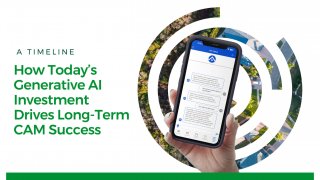- August 30, 2022
- CINC Systems

You’re thinking about customer retention all wrong.
If unfamiliar with the term, “stickiness” probably doesn’t sound all that appealing. Don’t worry, it’s a good thing. Basically, if a management company is “sticky” it means they have a high customer retention rate.
In 2022, CINC Systems surveyed the Community Association Management (CAM) industry to learn management executives’ goals for the coming year, and what they saw as the most significant hurdles facing not only themselves but the industry at large. It was expected that customer retention–or company “stickiness”–would be a topic high on everyone’s list–but it wasn’t. In fact, it was dead last, lower ranked than even the open-ended response option (a choice that notoriously holds the least engagement in a survey).
Despite that, management executives overwhelmingly viewed increasing customer satisfaction as one of their top three goals for the year. More concerning still was the fact that few management companies were even tracking customer satisfaction to begin with.
Even though a primary goal for many is to increase customer satisfaction:
- Less than 25% of management companies are tracking customer satisfaction
- Of the few that ARE tracking customer satisfaction, one-quarter of them are only using retention rate as their satisfaction indication
- Client churn was ranked as the lowest threat to overall company success
And seeing as client churn is one indicator (out of many, admittedly) that customers are not satisfied, it felt like there was something to be deeper explored.
What does this tell us?
Honestly, it tells us that management companies are overwhelmed. When diving deeper, the numbers showed that only 7% of small management companies (less than 1000 doors) measured customer satisfaction, and that number only reached 30% for mid-sized management companies (under 5000 doors). Smaller teams mean less bandwidth to take on tasks that don’t directly move the needle. Though this isn’t news, it is important to acknowledge the role that plays in missed connections just like this.
This information actually tells us that many management companies don’t recognize that although customer churn is indicative of low customer satisfaction, customer retention is NOT inherent proof of client happiness. It tells us that there is a disconnect between the idea of creating and maintaining happy customers, and the overall stickiness of the company.
It also means that growth and sustainability are not intentionally curated achievements, but happy accidents for many management companies. That isn’t to say success is unearned–just the opposite! It means that many management companies growing and sustaining, even without a plan to create that result actively (which is a testament to the fact that you are getting something right). That said, customer satisfaction is not a quantifiable measurement as it should be.
And what that means is that investing even slightly into measuring and curating customer satisfaction can be a massive game changer for one’s business. Actionably fostering stickiness will see immediate, long-term results that will help achieve that #3 goal of “improving customer satisfaction.”
Lastly, this reveals something that’s pretty true throughout the general workforce: people still fundamentally misunderstand customer satisfaction. This is clear because of the fact that customer turnover was ranked as the least threatening issue in the CAM industry right now.
The reality is that customer satisfaction is just a seat at the table. Management companies should be striving for a network of client evangelists: not just those who are content or happy, but those who would refer their management company to colleagues a dozen times over. These are the clients who can handle a less-than-satisfactory experience on occasion without it pushing them to leave negative reviews and discourage new business, or leave for a competitor.
Measuring Customer Satisfaction
The fact that so many management companies had absolutely no means of measuring customer satisfaction was simultaneously surprising and understandable. Especially for small and mid-sized companies (in any industry), to-do list items that do not directly or immediately contribute to growth or profit often fall to the wayside.
It was surprising because of how many management companies talked about wanting to increase customer satisfaction. How can one increase something they aren’t measuring yet?
As mentioned earlier, it’s likely because many management companies are conflating customer retention with customer satisfaction. On some level, retention may indicate a happy client, but it is not on its own proof–it’s just proof that they like their current services more than they like the idea of sourcing new providers, gathering bids, fighting their board to make a change, and so forth. That isn’t the kind of satisfaction that makes a difference long-term for one’s business.
Where Do You Start Measuring?
For those new to measuring client satisfaction, surveys are the place to get started.
The next step will be a series of internal checks owners and their staff can conduct over time. Tracking information like engagement levels and types, the general feedback from team members about those interactions, or the types of services clients utilize and show interest in can be incredibly telling about where they are in terms of satisfaction.
Conducting Surveys
There are multiple ways to measure customer satisfaction that have been proven to be effective for industries across the globe. Each of these is the industry gold standard for surveillance and tracking customer satisfaction levels long-term, and while some areas overlap, each will serve a purpose.
Customer Satisfaction Score:
CSAT is one of, if not the most, commonly used surveys when it comes to measuring customer satisfaction. Something as simple as a single question of “How would you rank your service today?” with a 1 – 5 star selector tool is a type of CSAT survey. This is a fundamental option that can be used at the conclusion of interactions like live online chats or phone calls with a customer service rep.
Customer Effort Score:
This survey is a powerful tool that can help one better understand whether their services are meeting the expectations of their clients. Asking clients about their experience in terms of the level of effort their client had to expend to accomplish their goal is incredibly important. Instead of gauging an emotion about a specific interaction, it offers a quantifiable insight into their experience.
Net Promoter Score:
NPS surveys are also one of the most commonly used surveys out there today. This type of survey works to figure out how likely a client is to refer the organization to others.
Because these surveys all cover different ground, they should be used simultaneously, rather than just choosing one and only tracking that one area. There are a variety of ways one can implement them to avoid overwhelming their clients. CSAT surveys can be built directly into an online chat function, and NPS scores can be recorded after customer service tickets have been resolved. All of them can be manually distributed via email after phone calls take place.
Behind the Scenes
Surveys are very important, but they filter all of the information through the lens of the customer. Everyone has had a singularly terrible or wonderful interaction which can, and do, influence responses provided in the heat of the moment. Those results are a great foundation, but they cannot be the only metrics used to measure customer satisfaction in order to gain a deeper reading into that ‘why’ factor that directly contributes to stickiness and client evangelism. Coupling those surveys with internal checks and metrics is key:
Level of Engagement:
This is a multi-faceted aspect of one’s business that can be used to determine where a customer lies in terms of satisfaction. Customers who call in once a day every day are probably not doing so because of how happy they are, for example. Conversely, customers who never communicate with or about the service – are one bad interaction away from walking away…or perhaps one or two very successful interactions away from becoming an evangelist for the organization’s services. Keeping tabs on customer engagement levels can even be done with some of today’s community management software, so the level of effort for a team should be very low.
Types of Engagement:
How clients choose to interact with an organization can speak volumes. The trick is to look below the surface. For example, if a client always uses email to communicate and those emails take anywhere from 24 – 72 hours before the client receives a response, one can reasonably assume that by day 3 of that waiting period, the client is probably frustrated. If another client sends an email, but then follows up with a phone call the very next day, it’s safe to assume they are looking for (and not receiving) speedy resolutions. Knowing the levels of engagement by channel for clients is the first step in resolving the negative interactions.
Staff Insight:
Just as one should be surveying clients after interactions they have with the team, the team should be asked about their opinion of the experiences. But more than that, managers should be given an opportunity to come up with solutions they think will benefit each specific client. Valuing and relying on their knowledge and input can go a long way in preserving and fostering long-term positive client relationships.
Rethinking Customer Satisfaction
Remember, satisfaction is the cost to get in the race, not the finish line to cross. So with that in mind, it’s helpful to take a quick step back.
It’s important to understand the ‘why’ that created a satisfied customer, but what about ‘why’ customer satisfaction became a priority? And why now? Why not eliminate client churn? Why not increase portfolio size? Why not add new services? And as it’s been asked before, why is client turnover not a consideration in relation to this decision?
Understanding the specifics that led to this goal for this year will not only help understand this decision, it will open the doors to a lot of deeper insight into other areas of company success as well: employee satisfaction and the role that can play in customer satisfaction, for example, or which services are generating the most ROI and happiness in your clients.
From there, the next step is to evaluate plans that generate client satisfaction.
Happy Isn’t Going to Cut It Anymore
When one reframes “satisfied customer” as the standard rather than the aspiration, it’s easier to define what it takes to achieve customer satisfaction, then nurture that into company loyalty and eventually convert each client into an evangelist.
Consider these Do’s and Don’ts when building out a plan of action for creating company evangelists:
Don’t Overpromise and Underdeliver.
Just as in any healthy relationship, a person can only take so many empty promises. These don’t even have to be big ones–simple tasks like missing meetings or phone calls, not responding to emails in the determined timeframe, or missing delivery dates even by a single day–it can all begin to add up in the eyes of the board. Those seemingly tiny friction points become a checklist of shortcomings that cannot be erased, even by major accomplishments.
Do Exceed Expectations Whenever Possible.
Going above and beyond sounds like an obvious, if not challenging objective to achieve. It doesn’t have to be (challenging, that is). Rather than overpromise and underdeliver, setting realistic, or even slightly bloated expectations that can easily be met and exceeded is the key to intentionally creating positivity among clients. Consistently overdelivering on small promises will generate lasting impressions that can be fostered into evangelism.
Don’t Expect Too Much of Managers.
Remember that community association managers are human beings with the same hours in a day as the rest of us. Remember that managers aren’t always going to get it right, and that there is no set standard for how to manage every community correctly. If managers are tasked with too much responsibility, or are not given adequate support and feedback, they are more likely to fail and in turn fail their communities.
Do Create a Manager Training Program and Communication Matrix.
Offering managers a set of hard-and-fast rules and expectations for their responsibilities is a great way to ensure consistent delivery from all managers for all communities. That level of consistency is going to create and enforce portfolio-wide stability and satisfaction. When building these programs for managers, be sure to include information on how managers respond to public negative reviews and the language managers should use when speaking with board members.
Knowing the Real Role of the Management Team
When measuring and addressing customer satisfaction in the year 2022 and beyond, take the time to reevaluate the role managers play in the long-term customer journey. With the sheer number of managers leaving the industry, and the continuing drought of incoming talent, many management companies are shuffling their teams around and reallocate properties as necessary. This is a pretty standard practice that can lead to catastrophic fallout for the exact reasons mentioned just above: expecting too much of managers, and lack of consistency.
Managers are the most significant part of your business: more than any advertising, more than any quality of phone or online chat representation, more than even the executives, because they are the face of the company. At least, they’re the face clients see. If that face is constantly changing, and if the treatment received from face to face, as it were, varies dramatically, it’s easier for small missteps to feel like major setbacks.
This communication template is a great first step in creating consistency amongst the management team:
| SAMPLE COMMUNICATION MATRIX FOR MANAGERS | |
| Community Visitation Frequency | Bi-weekly |
| Number of Board Meetings to Attend | 10-12 |
| Average response time for board communication | One business day |
| Average response time to homeowner concerns | Two business days |
Empowering Managers
This matrix is only the beginning of a larger plan. To put it into effect and see the full impact of how consistency creates customer evangelism and company stickiness, it’s up to the executive team to appropriately distribute responsibilities for managers. With adequate time in their day to dedicate to client experience, managers can ensure consistent quality of service.
Admins should do admin tasks.
-
- Instead of adding homeowner administrative tasks to the growing workloads of managers, redistributing that work to dedicated administrative personnel allows managers to focus on the tasks they are really there to do.
Maintain healthy portfolio sizes.
-
- Though this is a difficult ask for many community association management companies today, ensuring that managers are not overwhelmed with too many communities will give them more bandwidth to focus on their clients.
Give managers the right tools for the job.
-
- Project management systems are a great way to complete a bulk of the maintenance projects for the manager so they can stay focused on tasks that directly impact customer experience.
Customer Evangelism: the New Benchmark to Meet
When it comes down to it, happy customers are the most important part of any business. Recognizing that happiness should be an expectation, not a lofty goal, is the key to unlocking true customer satisfaction and company stickiness. Creating evangelists who support and espouse a management company’s quality of service and dedication will ensure long-term success for customer retention and minimize client churn.
For more information on how to reevaluate customer satisfaction, take a look at our full customer service white paper.
Related Reads

Blog
Keeping Calm and Carrying On: Leadership Tips for Turbulent Times
- November 20, 2024

Blog
AI at Bat: What Umpires, Baseball, and Data Security Can Teach Us About AI Risks
- October 28, 2024

Blog
Do I really need a homeowner app when I have a mobile-friendly website?
- October 14, 2024

Blog
Weathering the Storm: How to Adapt to Soaring HOA Insurance Costs
- October 1, 2024

Blog
How Today’s Generative AI Investment Drives Long-Term CAM Success: A Timeline
- September 16, 2024

Blog
A Common Sense Approach to Simplifying Budget Planning Get ready to conquer HOA budget season with this effective strategy
- September 2, 2024
